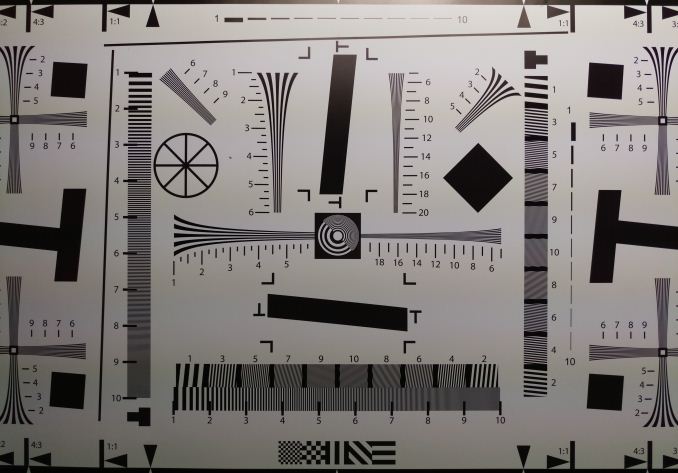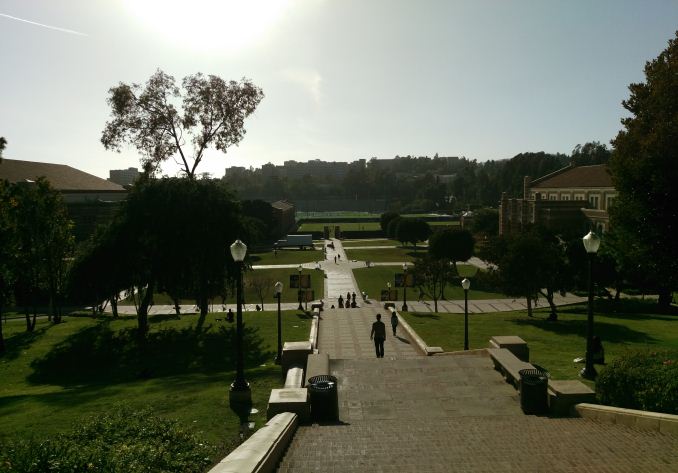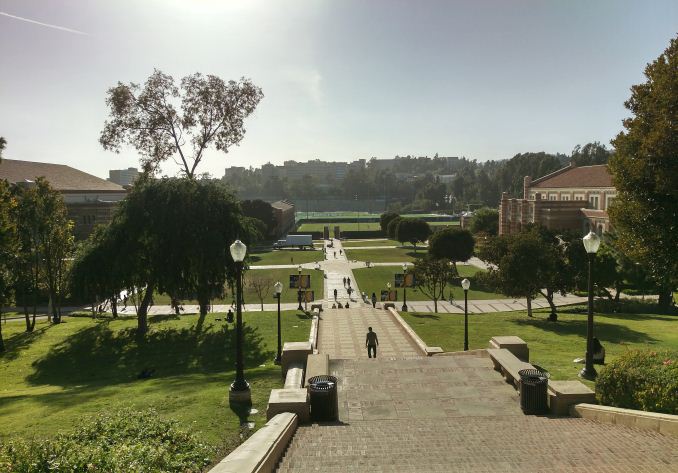The HTC One M9 Review: Part 2
by Joshua Ho on April 6, 2015 10:00 AM EST- Posted in
- Smartphones
- HTC
- Qualcomm
- Mobile
- Snapdragon 810
- One M9
Camera Performance
Now that we've finished going over the camera architecture and user experience of the One M9 we can talk about the end result, namely the quality of the still images and video that the One M9 can produce. Our first test is a basic test of spatial resolution, which uses high-contrast line pairs that make it possible to get a good idea for what the effective maximum resolution of the camera is.
In this test, we can see the benefits of the 20MP camera sensor of the One M9, spatial resolution in this test is a massive improvement over what we saw from the One M8. At the center, the resolution of the camera is sufficient to resolve up to the 20 mark. Resolution at the edges of the frame remains sufficiently high, with no obvious field curvature in this test. To get a more nuanced look of low ISO camera performance, we can look at some standard daytime shots to get a better idea of real-world camera performance.
Here we can start to see some of the real issues with the One M9's camera. It's immediately obvious that the sky here is just the wrong color. Although Los Angeles can be a smoggy place, the sky in this photo should be a stronger shade of blue, not gray with a tinge of blue. Looking at the texture of the roof, the grass throughout the photo, and the bleachers off in the distance, it's pretty obvious that HTC needs to strongly reduce the noise reduction that they're using here, as there's almost no detail in these photos. The detail is basically comparable to the iPhone 6's 8MP camera, which shouldn't be the case in these daytime conditions. The lack of shadow detail also degrades perceived quality. In general, the photo appears to be a bit underexposed as well.
With the HDR mode, all of the issues seen in auto mode are still present. However, to HTC's credit HDR mode is now usable instead of being almost useless as it was with the One M8. HTC still needs to focus on reducing halos as there seem to be issues with this on some high contrast edges/moving objects and make HDR a live preview similar to the Galaxy S5 and S6 camera, but in general this is a dramatic improvement when compared to previous devices.
In low light, the One M9 performs horribly. There's really not much else to be said because there's next to no detail in these photos. Noise reduction has smeared away what detail there was. Despite the fact that the photos have evidence of incredibly strong noise reduction, there's still a lot of noise visible in the image. Thankfully, the color noise of the image is low which makes things better, but for 1600 ISO and 1/9 second exposure time, the output is nothing to talk about.
Moving on the video quality, we can first look at 1080p30 quality. HTC uses a 20Mbps encode rate, using H.264 Baseline for video, and 192Kbps AAC for audio encoding. While the iPhone 6 can serve as a reasonable reference, there are a lot of apparent issues even if one doesn't look to the iPhone 6 for a point of comparison. In general, 1080p video doesn't seem to carry a great deal of detail with it, and it looks like there isn't any kind of video stabilization going on here. The result is that footage is extremely shaky and really kind of disappointing here.
For 1080p60 we can basically see the same story, as the One M9 still has a noticeable lack of detail and there are a lot of problems with camera shake that aren't dampened out. It almost looks like HTC doesn't have any kind of stabilization for video here, which is rather disappointing. The bitrate of 1080p60 footage is also unchanged from the 1080p30 settings, which is a bit curious.
For 720p120 slow motion, HTC does manage to capture real 720p footage instead of upsampled 480p video, and it compares favorably to the iPhone 6 but detail continues to be a problem here. The encoder settings are similar to 1080p30 with its H.264 Baseline setting, but bit rate is reduced to 12.1 Mbps.
Overall, the performance of the One M9's camera is disappointing. Overall, it's still probably better than the One M8's camera, but the execution is lacking. HTC needs to focus on improving detail by avoiding aggressive noise reduction, reduce aggressive sharpening, improve shadow detail, implement effective EIS and OIS, and work on improving auto-focus and capture latency. It's concerning that HTC still cannot come close to the competition in this area, and given that camera is a crucial aspect of any smartphone experience HTC needs to resolve all of these issues if they want to remain relevant in the smartphone market.






































127 Comments
View All Comments
Dorek - Wednesday, April 8, 2015 - link
He probably means the life of the company? If they keep releasing phones this bad, they WILL go out of business.KiretoX - Monday, April 6, 2015 - link
I don't really understand why HTC first had a good idea and tried with 4Mpix and then instead of going in the middle between resolution and quality went right away to this terrible 20Mpix sensor? It would have been interesting if they went to something around 8-13Mpix... which is just fine resolution-wise. So now they first failed with low 4Mpix and now again failed with the super high 20Mpix...Laxaa - Monday, April 6, 2015 - link
It really seem slike they just rushed as far as they could in the opposite direction when deciding the specs for this camera. Ultrapixels was a good idea and a middle ground would have been nice. Maybe something like the iPhone 6 but with OIS.How large would the pixels be on a 8.3 MP(4K capable), 1/2.3 sensor be?
pjcamp - Monday, April 6, 2015 - link
HTC doesn't have the market share to request a custom sensor like Apple. They have to work with whatever standard parts are available off the shelf.melgross - Monday, April 6, 2015 - link
Yes, and they could,d have gotten an 8MP sensor off the shelf, or. 12-13MP version, or even a 16MP. They didn't need to go all the way to 20.It almost seems as thought they didn't even look at the specs, just the pixel count. And then they got rid of the camera processor as well. Very bad move.
Dorek - Wednesday, April 8, 2015 - link
"And then they got rid of the camera processor as well. Very bad move."Yeah, this is ridiculously stupid. I had a dumbphone in 2008 (the Motorola Zine) that had a separate imaging co-processor, and as a result it had autofocus times and shot-to-shot times on par with any 2015 smartphone. An imaging co-processor goes a LONG way.
LordConrad - Friday, April 17, 2015 - link
I would have preferred an 8 Ultrapixel camera on the M9. More incoming light and plenty of pixels for a phone camera.sinPiEqualsZero - Monday, April 6, 2015 - link
I'm sad to see this. Did no one at HTC use the phone before releasing it? I was hoping the M9 would be my new Windows phone later in the year.May need to switch to Android if no good flagships come out...perhaps the G4.
Thanks for the thorough review, Josh.
J4ckb1ng - Monday, April 6, 2015 - link
HTC's are Android phones. Me, I'm happy the M9 is not vastly different from the HTC M8. The M8 is my first smartphone and I don't regret my decision. I wish the M8 battery life were longer, but I'm glad overall that I have no urgent need to ditch the M8 for the M9.Refuge - Monday, April 6, 2015 - link
HTC Phones are also Windows phones. They have the flagship M8 in windows flavors, go look.If the M8 is your first smartphone I can see why you love it, it does feel premium and it is a good phone. Better than this M9 is if you ask me. But I honestly still feel that the ONE M7 was by and far the best phone of their ONE Mx lineup.
I'll definately be keeping this phone for the time being, HTC has nothing worth upgrading to if you ask me right now.